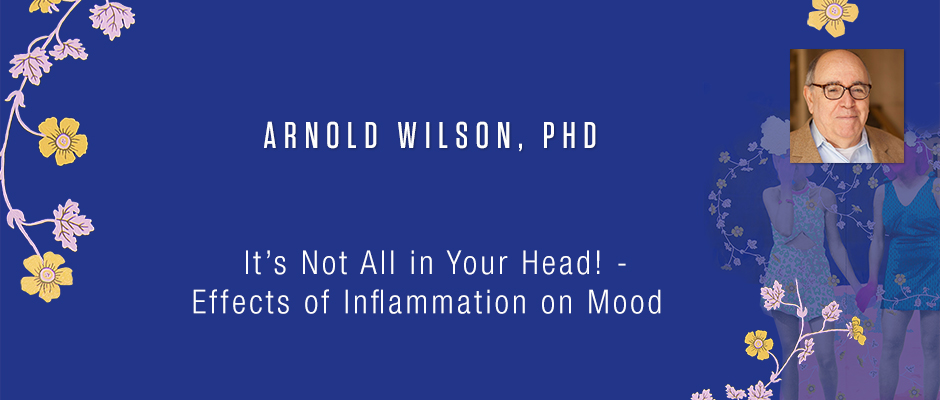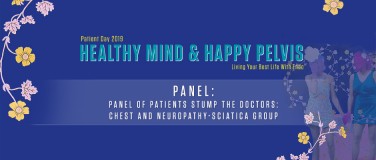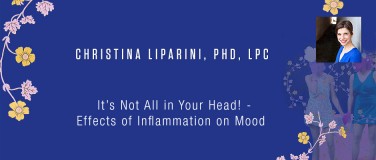Arnold Wilson, PhD - It’s Not All in Your Head! - Effects of Inflammation on Mood
Patient Awareness Day 2019: HEALTHY MIND & HAPPY PELVIS
Living Your Best Life With Endo
March 10, 2019 (8am - 5pm)
Einhorn Auditorium, Lenox Hill Hospital, New York City
https://www.endofound.org/patientday/2019
Hello, everybody.
Ever since the last talk, I've been chugging water. And I have no intention of stopping.
Good morning. Dr. [Seshne 00:00:30], Dr. [Deyou 00:00:31], Dr. Goldstein, all the team that I work with. Let's have a patient morning, patient day on a Saturday some year, but I'm not here to complain, I'd like to spend a few minutes today talking with you about anxiety and panic.
I want to suggest that there is a continuum between normal anxiety and what might be termed a panic attack.
Allow me to first set the stage by painting the picture of a viable model. Imagine this, it is 250,000 years ago, our ancestors are huddled around a campfire and the sun is going down. The children are playing before getting ready for sleep, which in those days coincided with the diurnal descent of the sun.
Suddenly a saber tooth tiger appears. Now, what is that our ancestors should do? Answer, get anxious. Repeated instances of such events, and the adaptations through survival of the fittest leads to the anxiety in the service of survival that then becomes ingrained in the DNA as a response to the anticipation of danger.
The anxiety pointing to danger needs these ancestors of ours to accomplish certain things, having a great adaptive advantage. Then what happens, the heart starts to beat faster. Blood is drawn from the bodies extremities to the heart in order to increase oxygenation for either fighting or running. The sudden decrease in oxygenation may make the person feel somewhat faint, or dizzy, or his or her extremities feel cold, adrenaline may pump leading to enhanced short-term performance and strength. But the feeling of weakness and depletion shortly thereafter.
The individual may sweat profusely, even though it may not be cold. Because the body is performing as if in an athletic event despite the absence of over performance.
Does that sound familiar to anybody?
Now, genetics are a funny business. It turns out that anxiety and panic are coded on a minimum of five genes. And there is quite a complex interplay between these genes. It is not at all unusual when genes are mixed during conception, two gene pools are mixed, for different configurations of genetic coding to be established. Sometimes, one gene will not hitchhike a ride into the next generation, but may then be restored during a following generation.
This leads to a remarkable set of individual differences in terms of how individuals evoke and respond to anxiety.
Because humans are what they are, over time the anticipation of danger became extended from only external factors to internal factors as well. Thus, it is now just as likely for an internal danger factor such as loss of love, or loss of the object, all the things that are taught to us by psychoanalysis to evoke anxiety and the rush towards solving it.
This was an epic shift when internal dangers became as potential toxic as external dangers. We have come a long way and evolved both as people and as cultures since all we had to do was simply fight a saber tooth tiger.
Now, here's the kicker, with internal danger often there is no real solution possible. So some people live in a perpetual state of high anxiety. In endometriosis, the young woman battles a unique and potentially debilitating set of interactive internal and external danger factors that profoundly tax her ability to remain nice and stable with respect to anxiety.
At a certain point, it is not unusual for the various dangers, some of which as I mentioned are not easily solved to pass a critical threshold and lead to a panic state. It is our job as those who tend to the health of the mind and body of our patients to help a woman with endometriosis to pass through and beyond this complex configuration of danger situations.
Unfortunately, I cannot stand here this morning and testify that the field accomplishes this very well. Our failures lead to some real world consequences that I would like to briefly mention.
What anxiety and panic do is grab hold of what are called appraisals and magnify them, what was moderate and temperate becomes extreme. As the woman with endometriosis undergoes misdiagnosis after misdiagnosis at the hands of medical personnel over time who do not understand endometriosis. The impact of the danger situations multiplies geometrically. Pain forever, no children or family, a life of incapacity and perpetual pain.
This is a virtual incubation setting for anxiety and panic. Who can be trusted? Who can be a confidante? What is happening to my friends who are tired of me canceling every Friday and Saturday night outing? Will I ever be able to earn a living?
Here we not only ignore dangers, but we allow them to multiply. Perhaps using the word allow itself is an understatement, perhaps a better word is promote.
Most medications fail at solving this, and I'm not telling you anything surprising, I'm only telling you what scores of women with endometriosis have told me already.
Perhaps the best of a very bad bunch of SSRIs is duloxetine, because it doubles as a pain killer. As people vote with their feet, probably the best stop-gap solution is to carry something like a benzodiazepines, like Klonopin, or Xanax, or something like that, wrapped in a tissue in your pocket and take some when you feel an inordinate amount of anxiety or panic coming on. It will numb you and at times short circuit the body's attack. After three or four hours though, the medication goes away and you're back where you began waiting with trepidation for the next episode. Surely we can do better than that.
And the woman with endometriosis experiencing anxiety and panic looks to many prescribers as if they need high doses of medications. Actually, and I want to say this with capital letters and I want you to take this home with you, most women with endometriosis display hypersensitivity to drugs of all sorts, particularly psychotropics, but also pain killers, antibiotics, etc.
I think it is fair to say that few prescribers understand that, whereas, someone might start at 10 milligrams of drug X, when someone has endometriosis you start at two milligrams of drug X, or the individual will experience debilitating side effects.
Please all perspective patients in this audience remember this and educate your prescribers about the need to start low, go slow, and stop a lot along the way to make sure that you indeed may or may not require more. The algorithms for others who do not have endometriosis simply do not apply to you.
I know there should be a [inaudible 00:10:37] here, I've diagnosed a problem and now I should be able to provide a solution. The diagnosis of a dilemma like this is not a box to be put in. But rather as a roadmap, and we need to provide the destination. The problems of anxiety and panic in endometriosis are profound, and they defy a quick and phasal fix.
Psychotherapies are available but what I want to convey to you is that you search out a practitioner and not a technique. The research that is available the psychotherapy process and outcome research suggests that the most salubrious outcomes occur with a well trained practitioner and it accounts for much more variance than the technique that the person articulates.
Make sure that they know and understand endometriosis. There are conscious and unconscious factors at play. There are vast individual differences to be considered and everyone involved should suspect any easy and obvious solution, that promises utopian results. But at minimum, at minimum, you should know that we are aware of the problems and are thinking rather franticly about how to best address them.
Thanks.










